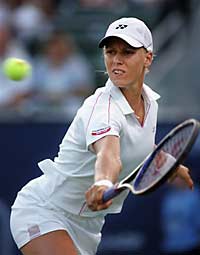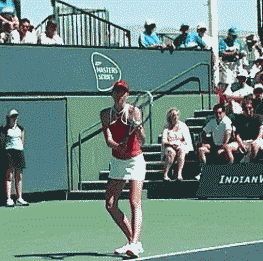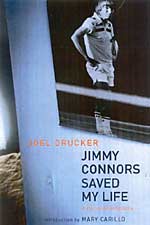|
TennisOne Features
The Russians Are Coming! By Joel Drucker
The Russians arrived in a big way on the WTA Tour this summer. First came Anastasia Myskina's win over her fellow Russian Elena Dementieva in the French Open finals. Then, in a victory surprising more for its timing than occurrence, Maria Sharapova dismissed Serena Williams in the finals of Wimbledon. Assuming Sharapova hasn't been too distracted by her sudden rise in fame, she should feel quite comfortable on the US Open's hardcourts. In fact, I wouldn't be surprised to see at least three of them reach the quarterfinals of this year's US Open. And given all the injuries and distractions that have overtaken women's tennis this year – defending champion Justine Henin-Hardenne's only played one event this summer, the Williams sisters have looked quite stale – a Russian might even emerge as a winner. That would be quite a remarkable feat to see a bevy of Russians take three Slams in one year. So are we likely in for a Russian domination of tennis akin to the great Australian men of the ‘50s and ‘60s? I think not. The better model is more likely the Swedes of the ‘80s and the current batch of Spanish and Argentine men. These Russians figure to be right in the thick of the top 50 for at least a decade. Still, it's not certain to me if that many Russians have the physical or mental tools to win multiple Grand Slam titles or become number one on the world.
On the plus side, the Russian women have tremendous work ethics. Leave the preening and talk of outside passions to Serena. Myskina and Dementieva each play well in excess of 20 tournaments a year. Now that Sharapova's old enough to commit to a full schedule, she figures to trot out frequently. And ditto for the ones lesser-known to the general public such as Nadia Petrova, Svetlana Kusnetsova and Vera Zvonereva. All of these women compete vigorously and practice diligently – both on and off the court. Even Sharapova, invariably given her share of fashion shoots, repeatedly stakes her desire to be thought of primarily as a jock, not a model.
I'm particularly high on Sharapova and Kusnetsova as future champions. Sharapova stepped on to Centre Court as if she owned it, showing no intimidation versus anyone, scorching the lines in a manner reminiscent of Monica Seles. She alone to me is the Russian most likely to win multiple Slams. Kusnetsova strikes me as a more mobile Lindsay Davenport, a keen ballstriker still searching for those extra pieces of savvy and subtlety that separate the near-great from the great. But the others to me are in some ways twisted victims of their nation's tunnel-visioned pursuit of success. Petrova has a wonderful allcourt game, and I still hold hope she'll be able to eventually harness it with consistency and at least win her share of WTA Tour titles. The bigger concern I have is that all of the Russians come from a nation that separates wheat from chaff at an extremely young age. As one might expect from a nation where tennis is seen not just as a game, but an economic salvation, the Russians have been bred with a hyper-vocational approach. This leads to a very narrow definition of what constitutes a successful tennis player. Accordingly, these women are each in some way rather limited when it comes to varying their speeds, spins and, invariably, their tactics.
There is very little of the liberal arts diversity that enabled the likes of a Martina Hingis or Justine Henin-Hardenne to build broad-based games that could hurt opponents in many ways. And since these Russians lack the serves to overcome those limits (there are club 4.5 players with better motions than Dementieva's), my fear for the Russians is that their strategic limits could hurt their ability to maximize their exemplary dedication and desire. Don't get me wrong. I give Myskina tremendous credit for her fitness, tenacity and groundstrokes. She should not be faulted for the shortcomings in Paris of a whole slew of contenders (Jennifer Capriati should kick herself for winning but four games in their semi). It's quite clear that mere survival – keen fitness, good health – will give Russians many chances to hold up a few trophies. Coming into this year's US Open, for example, the only top contender who's shown both the right mix of seasoning and performance has been Lindsay Davenport. That gap might be enough for yet another Russian to take a Slam this year. All players from that nation show first-rate desire and focus. But just once in a while I'd like to see one of them try a surprise serve-and-volley play at 40-love. It would add a lot of spice to what's already a very hearty Russian stew. Your comments are welcome. Let us know what you think about Joel Drucker's article by emailing us here at TennisOne .
Jimmy Connors Saved My Life: A Personal Biography Longstanding TennisOne writer Joel Drucker has just published his first book, Jimmy Connors Saved My Life: A Personal Biography. Mr. Drucker provides the most thorough examination ever attempted of one of the most complex characters in recent sports history. The book is both a comprehensive biography of the controversial tennis star and a look at how the author's life intersected and conflicted with Jimbo's. The book includes extensive analysis of Connors' tennis, including the vital impact his mother had as his primary coach, as well as the significant work the great Pancho Segura did in his formative years. Also covered are a great many of Connors' most important matches, as well as many personal interactions Drucker had with Connors that reveal unusual sides to him. |

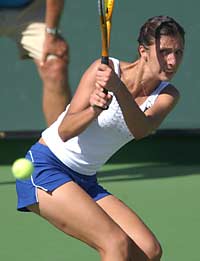
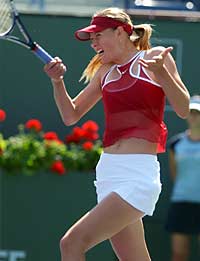
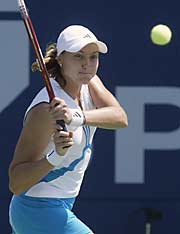
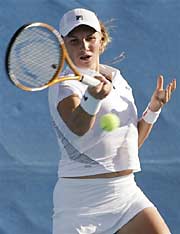
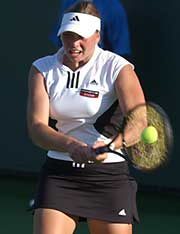 (From left to right) Petrova has the best all-court game, Kuznetsova needs a little more polish, and Zvonereva is unintimidated by anyone.
(From left to right) Petrova has the best all-court game, Kuznetsova needs a little more polish, and Zvonereva is unintimidated by anyone. 